One of the things most people have concerns about when growing microgreens at home are the light. Do I need to invest in a grow light, or is it enough with natural sunlight? How do they work, and which one is right for my setup?
There are many options, and trying to find the best grow lights for your setup can be a daunting process. The specifications speak about watts, lumens, spectrum, and other metrics. How do you even know what to look for?
With this guide, we will go over the different lighting options, how to interpret the specs, and what works better for different setups.
So let’s get to it!
- How do you know if your microgreens need artificial lights?
- Lighting requirements for microgreens
- What color light is best for microgreens?
- What is the best light for growing microgreens?
- Select the best option for your needs
- When should I expose microgreens to light?
- How many hours of light do microgreens need?
- Summary
How do you know if your microgreens need artificial lights?
First, you may ask if you even need to use artificial lights. The best way to know if your microgreens need to be placed under grow light is to look at the health of them. The same as with any other plant, microgreens need sufficient light to grow.
Using natural sunlight is the cheapest and most complete spectrum light source available, but if your microgreens are not growing well, lack of light might well be the reason. It may cause them to wilt, not grow tall, and leaves can turn yellow. If you don’t have access to necessary sunlight and want to grow all year round, then placing your microgreens under a grow light will help.
That said, if you are growing microgreens for home and not commercially, you don’t need to invest in advanced and expensive grow lights. If you have a few trays on the kitchen table or planning to setup up a small rack and want to make use of grow lights, there are reliable and economical options.
If you are growing large scale and using multiple vertical rack systems, there are growing lights aimed for commercial production.
Lighting requirements for microgreens
When you start to search, you will see that lighting specifications can be very technical. Learning how to interpret the many metrics used to describe the light system can leave you with more questions than answers.
Let us start by explaining the key concepts that are great to know before you search online, head to your nearest garden center, or home goods store. You certainly don’t need to be an expert or techy savvy to select your light for growing at home, but it can be good to have some knowledge as you start to compare your options.
This chart provides generic guidance on the different metrics to consider for grow lights for growing microgreens.
| Metrics | Description | Recommendation |
|---|---|---|
| Watts | Watts measure the amount of electricity used at a specific moment. You can say it measures power. The higher the watt, the brighter the light, but also the more power it uses. On the contrary, the lower the watt, the less energy used, and that equals less cost. | 20 watts per light |
| Lumens | A lumen is a technical term for the quantity of light leaving a lamp. So to simplify it, it determines the ‘brightness’ of a bulb. The higher the lumens the brighter the light. | 1700-2000 |
| Colors | All light sources contain a spectrum of colors. To grow microgreens (and other plants), we get the best results if we can provide the full spectrum of lights. You will then get the optimal combination of all colors required for healthy growth. | Full-spectrum |
| Kelvin (color temperature) | In essence, the color temperature describes the light appearance provided by a light bulb. It is measured in degrees of Kelvin (K) on a scale from 1,000 to 10,000. The higher the color temperature, the more blue-ish the color is. Light sources with a lower temperature tend to be redder. Daylight is 6500K, and we want to simulate this as much as possible. | 4500K, preferable closer to the range of 6000-6500K. |
How many watts do microgreens need?
The growing time of microgreens is short, and we don’t want them growing past the first true leaf stage. So, to grow microgreens you don’t need to use high watt light bulbs.
If you are growing a 10/20 tray on a rack, we recommend using 2-3 grow lights holding 20 watts each.
Some grow lights come with 300W, but you don’t need this for growing microgreens, it’s more for growing a mature and fruiting plant.
RELATED: Do Grow Lights Provide Heat Too?
What color light is best for microgreens?
For growing microgreens, the best color light is to use the full-spectrum. We are using artificial grow light to mimicking natural outdoor sunlight and the sun contains all colors of the light spectrum. Even beyond what we can see with the naked eye. When we are seeing the light from the sun, we see it as white. If you are lucky to see a rainbow, and then you will see all the colors that the sun provides.
Sunlight is made up of many wavelengths—or colors—of light. … So when the light exits the water droplet, it is separated into all its wavelengths. The light reflecting back to you, the observer with the Sunlight coming from behind you, from the water droplets will appear separated into all the colors of the rainbow!
Source: SCI Jinks
When a LED light is being constructed the colors that are placed inside can vary. The different colors are chosen depending on what kind of response we want to achieve from plants. Grow lights are adjusted to provide different wavelengths of certain colors so that plants and microgreens grow faster and healthier. All of the colors serve a purpose.
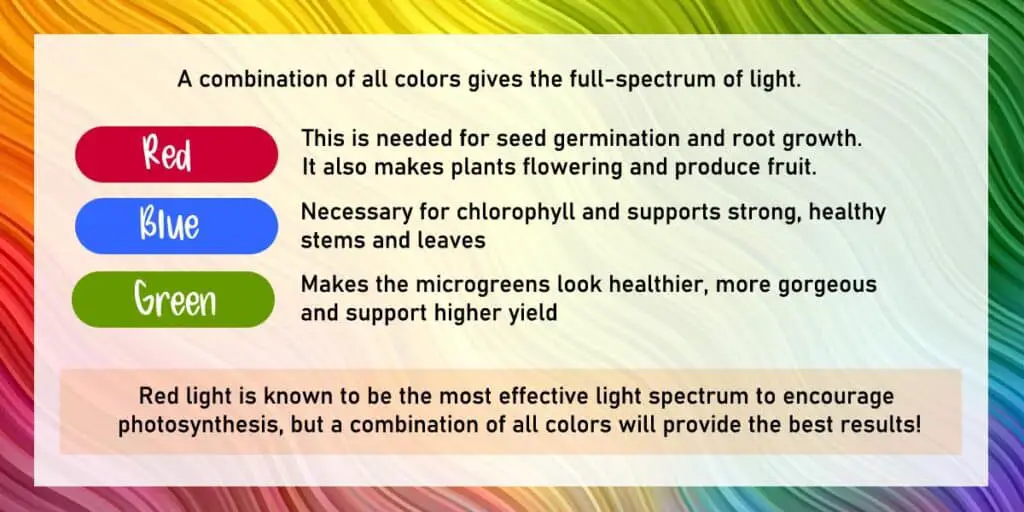
White light as a single color doesn’t exist but it is a sum of all possible colors. A full-spectrum grow light that provides white light has all the colors needed.
Using lights that only have red and blue will work for growing microgreens, but you will miss out on some benefits of the other colors. The illumination of these lights is as well often much stronger and less pleasant for the human eye.
A grow light that includes all the colors will give you the best outcome. The reason for this is that all colors have a purpose and together they make a closer match to sunlight.
What is the best light for growing microgreens?
There are many different types of grow lights, and it can be overwhelming to find out what is the best solution. I remember when we started our research. We spent a lot of time trying to understand the different options and what they mean (Incandescent light, LED, HID, HPS, and fluorescent lights). In the end, we realized that it does not have to be so complex.
To grow microgreens at home, we recommend using LED grow lights. We will go into more detail about why LED Grow lights are the best light for growing microgreens indoor, but let us sum up what the different types are and if they favor growing microgreens.
Incandescent bulbs – These are the old bulbs we used to have before LED was introduced into our homes. These types of bulbs are now extinct and have been fully replaced by LEDs. If you have some left in your drawer, we would not recommend using them as they will not provide the right grow light and they are not energy efficient.
HID (High-Intensity Discharge) is mainly used to grow larger plants. They produce high-intensity UV rays and we consider them being too strong for microgreens. They provide commonly 250 watts to 1000 watts, and that is way more than you will need.
HPS (High-pressure sodium) is as well mainly used for growing larger plants. As they produce a high amount of heat they are not ideal to place close to microgreens. Furthermore, they are less efficient as they use much more electricity to generate light than comparable LED grow light.
Fluorescent lights are commonly used for growing plants and microgreens at home. They provide full-spectrum light and produce low heat, but they consume more energy than LED lights. They are not as environmentally friendly as LEDs, and they contain a small amount of mercury, which is toxic (so be careful not to break this light!)
LED Grow Lights
LED stands for light-emitting diode, and they are great all-around indoor plant grow lights and our preference. The lights offer the full spectrums to best meet microgreens needs.
One of the main benefits of using this type of light is because of electricity savings. LED lights are extremely energy efficient.
They are in general a bit more expensive to buy, but you must consider that the running cost is lower. They last usually up to 50.000 hours, and if you are having your lights on a timer for 17 hours a day, they will last you 8 years!
Another reason to choose LED Grow lights for microgreens is that they produce a low amount of heat, and that means that you can place them closer to your trays than other alternatives. It’s specifically beneficial if you are growing in areas limited by height.
Finally, a key advantage is that you can recycle them and hence environmentally friendly. This type of light is free of harsh chemicals, and they do not transmit UV rays.
The main benefits of using LED grow lights are:
- They are energy-efficient and durable
- They are versatile as they come in different shapes, are smaller, and don’t require much space
- They produce low heat and be placed close to the trays
- They produce the full spectrum of lights required for photosynthesis
- They are 100% recyclable and your most environmentally friendly option
Comparing with other types of lights, we have not found any downsides of using LED grow lights.
Can any LED light be used as a grow light?
There is a key difference between LED grow lights and regular LED lights used in homes. The light bulbs you use in your lamps provide illumination and have the full white spectrum, whereas the LED grow lights have the full-color spectrum of lights. All of which are supporting vegetative growth.
If you place your microgreens under standard LED bulbs as your only source of light, it may not be enough for them to thrive. Grow lights, on the other hand, create an artificial light source that supports the chemical process of photosynthesis and gives the full spectrum your microgreens need to grow healthy.
We have listed a few different types of LED Grow lights that are suitable for growing microgreens:
MARS HYDRO – TS 1000W Led Grow Light
T5 Samsung Grow Light – Full spectrum
Elaine – 60W Indoor Grow Light
Smart Garden Hydroponics Growing System with Bamboo Frame
The reason we chose LED Grow Lights
We have chosen to use LED Grow lights because we want to have a long-term cost-effective, yet reliable solution. Using LED lights reduces our energy consumption, is more environmentally friendly, and does not create overheating even when we use it daily. We needed a light that can be fairly close to our trays as we use a setup with non-adjustable shelves.
Another important factor we took into consideration was the color of the light (for the eye). We want the grow light to produce the full spectrum of light, but at the same time, we don’t want to have the pink/purple light. We have our growing rack in a room which we also use as an office. For this reason, we went for a light that provides the full spectrum but provides the white light to create an atmosphere that works with our day-to-day life. Using the pink/purple would give the entire room a light we cannot feel comfortable with.
It may be tempting to go for the cheaper option and use standard LED lights, but in the long run, we’d recommend you go for the specific LED grow lights.
The different types of LED lights and how to set them up
Even within LED lights, there are different variations:
LED Grow Light tubes/bars
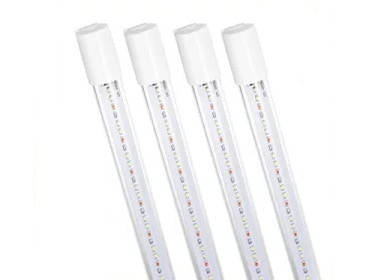
A commonly used LED grow lights come in tube shapes or bars. These lights are mainly used when you have a vertical rack system or another shelf setup. Depending on the light and brand, you will get different accessories for installation.
They can easily be installed with a chain hanging construction, double-sided tapes, clips, and/or cable ties. If you are using a grow rack, you have to attach your grow light tubes. You can do this by fastening lights with a hanging construction (chains and s-hooks) or with Zip Ties to the shelves. Some of these lights even come with double-sided tape that allows you to stick it on the surface you want.
Flexible LED Grow Light strips
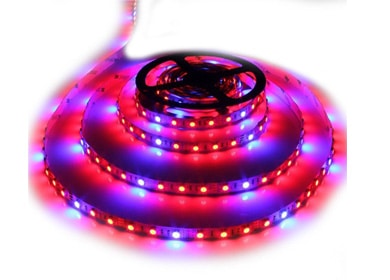
The grow light strips have a flexible design that you can mount on any flat surface. The benefit of using this type is that you can place them not only vertical but in any suitable direction using cable ties or adhesive tape. Some may even be cuttable to the preferred length.
The flexible design is a good alternative if you want your setup to be more discreet than using lights with a hanging construction.
To mount the light strip rope you can use zip ties or use a strength strip adhesive that sticks to any surface.
LED Grow Light with box-shaped fixtures (Quantum board)
This light comes with a box-shaped fixture and it provides a squared cover area that provides an evenly spread light. The lights have a hanging construction that is easy to assemble. Same as for the tubes.
LED Grow Light with clip design
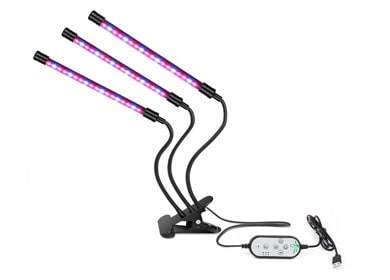
This flexible grow light can be used if you have a tray on a kitchen table or any other place where you cannot install a hanging construction. The grow light with a clip takes less space, and you just attach it to a table edge or any other surface.
The metal clamp allows the lamp to be fixed to ledges, shelves of seedling shelves, table, or other surfaces. It is as easy as that. Some of these lights also have an adjustable gooseneck between the clip and the lights. This allows you to move the light to the position you need.
LED Grow Light Complete Growing Garden with integrated light
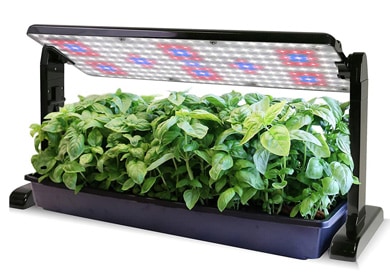
If you want to invest in a complete indoor garden, there are great options that have the integrated full-spectrum light. These setups are ideal if you don’t want to have a grow rack. They also come in various designs to blend in as a small piece of furniture!
All of the above different LED Grow lights come with various features such as dimming control, integrated timer, and even allowing to manage the lights remotely. These extras can be useful depending on your setup and the time you must watch over your growth.
The complete ready-made setups, such as the AeroGarden Grow Panel or the Ecogrower hydroponic garden kit with integrated light doesn’t require any installation. These products are fully assembled and the only thing you have to worry about is to place your tray under the light and turn on the plug.
RELATED: Can you grow microgreens in an AeroGarden?
As you have learned there are as many types of lights as there are ways to set them up. It is common to use a grow rack when you want to grow more than a single tray, and we have listed some things that you should contemplate before you install your lights.
- If you are growing microgreens in 10/20 trays or two 5/10 trays, you would probably need 2 to 3 lights setup per shelf. That will give an even amount of light.
- The ideal space between the shelves is around 8.25 inches. It gives you enough room to adjust light spacing.
- Use a tie wire or string to fixate the lights.
- Plug all the lights into one power bar so that you can conveniently turn on and off all lights at the same time.
- If you are using lights that can be adjusted in height, begin by hanging them about 1″ above the seedlings. Adjust the height of the light as the seedlings grow.
- If your shelves are fixed, you can instead use trays or other containers to build some height and place your trays on top.
Select the best option for your needs
To help you decide on the grow lights that fit your need, you can ask yourself some key questions. They will help you to decide what option is best for your setup.
Where will grow your microgreens?
The first thing you should consider is where are you are growing your microgreens. Depending on where you are placing your trays in your home, the choice of light will vary.
If you are growing a single tray and want to be able to move it around, using a grow light with clips may be an option. On the contrary, if you have a shelf system / growing rack, you may want to use the tubes or strips. There are also Grow Light Gardens that come with the entire package, including the shelves and light. Some are made from bamboo with great design. So, there is something for every taste and need.
What is your budget?
The LED grow lights come in a wide price range. So, your budget will also set some limits. However, as mentioned, for growing microgreens, you don’t need an advance setup, and there are excellent and economical options. You have grow lights in the range from 30 to 150 dollars. If you want a full-fledged grow light garden, you may see a price tag of around 900 dollars.
When it comes to light, you should also consider the running cost, meaning how energy-efficient they are, not just the one-off.
When should I expose microgreens to light?
Most types of microgreens need darkness during their first few days, and they all need light to grow. As part of the growing process, you will first put your seeds in the dark to allow them to germinate (what we refer to as the blackout period).
Microgreens needs, in general, from two to eight days in darkness before you expose them to light. The time will vary depending on the type of seeds you are growing as well as temperature, moisture level, and seed quality. All these factors play a role in determining the growth of microgreens.
RELATED: When should you expose microgreens to light
How many hours of light do microgreens need?
Different types of microgreens require a varied amount of light, but in general, you can consider that you must provide them a minimum of 6 hours of light per day. The more ideal is to provide them around 12-15 hours of light per day and keep them in the dark from 9-12 hours.
Summary
Choosing a growing light is not an easy task. With the numerous options available, it can be daunting trying to find out what is the better choice and what works for you. We hope that by providing you with our research and own experience, you are better equipped to find the best grow lights for your indoor setup.
It can be tempting to go for something cheaper or even use household lights instead of proper grow lights. Doing that can be wasteful. We have grown microgreens using only sunlight, using indirect and irregular light, and the results have been uneven growth and overall not as good as it could have been. Using full spectrum grow light will give you better results, and your investment and efforts will be worthwhile.
Select the grow lights that fit your budget and needs. In general, we are in favor of using LED Grow lights as they are far more energy-efficient, as well as environmentally friendly and safe to use. They have been easy to manage, and more importantly, they are giving good results!


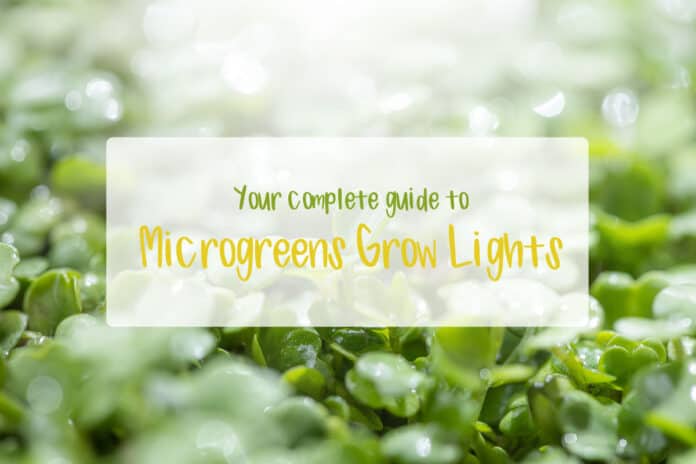
Thank you! This was very helpful and useful information!
Hi. I’m new at this and bought Burrina t5 Led shop lights 6500K 1100Lumens 10 watt each. I now think maybe the wattage is too low. For microgreens. Would I need to put more than two per shelve? I would love to hear your thoughts. Thank you.
Hi Karen,
I am not 100% sure if it’s the same model you have bought, that I am looking at. Could you do me a favor a drop me a link on our email, so I know for sure I am looking at the right product.
Best
Jesper
Thank you so much for taking the time to share your knowledge!
Hi Denise,
I’m glad you found it useful.
Best